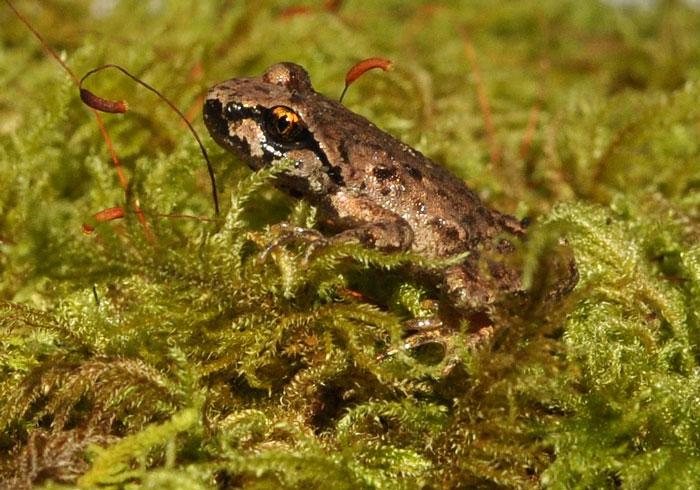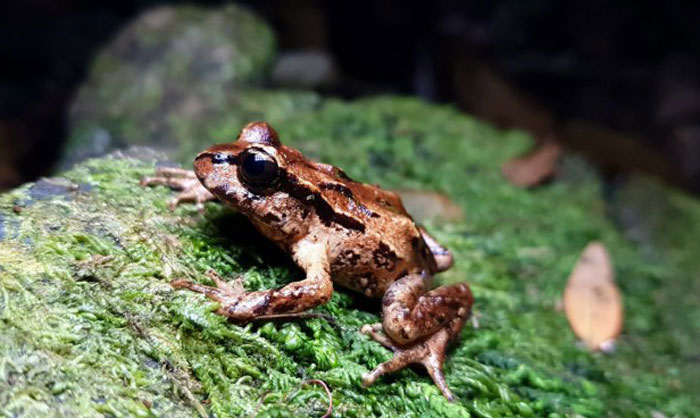Tailed frogs are small frog species that inhabit the Pacific Northwest region in North America. They’re widely recognized by one distinct feature—a long tail whose role is not yet clear but it is believed to be helpful during reproduction.
They also feature flattened bodies and webbed feet that make them great swimmers in aquatic environments.
Knowing more about these frogs is important as they play a crucial role as predators and prey in their freshwater ecosystems. As a result, they control the population of insects and maintain the health and biodiversity of their ecosystems.
Moreover, they act as indicator species for the health of freshwater ecosystems. This is because they are highly sensitive to water quality and environmental changes.
Unfortunately, tailed frogs have multiple threats—such as habitat loss, pollution, the introduction of invasive species in their natural habitats, etc.—which affect their numbers in the wild.
Therefore, it is necessary to study these frogs and understand their biology, ecology, and threats they face. This will help discover effective strategies for mitigating them to ensure their survivability.
This article discusses everything you need to know about tail frogs, including their physical characteristics, habitat, behavior, conservation status, and other interesting facts about tailed frogs.
Species name:
- Common names: Tailed Frog, Coastal Tailed Frog
- Scientific name: Ascaphus truei
Classification:
- Family: Ascaphidae
- Genus: Ascaphus
- Species: Ascaphus truei
Physical Characteristics
Tail frogs are small amphibians, with an adult growing to a maximum length of about 1.5 to 2 inches. Females grow larger than males. The frogs have slender bodies and rough toad-like skin.

Its head is pretty big and flattened, and appears broader than it is long. They also feature vertical pupils and small bumps on their skins, which give them a pebbly appearance.
Tail frogs’ unique features:
- Distinct long tail: This is believed to be an external reproduction organ (or simply an extended version of the cloaca). The frogs use it during internal fertilization. The males have the copulatory organ at the base of this tail.
The tail helps direct the sperm into females when mating in fats moving waters, helping reduce sperm loss. Females use the tail for laying eggs in fast-moving waters. Moreover, the frogs use their tails for balance and stability in their aquatic environments.
- Camouflage coloration: The frogs also feature a unique coloration that enables them to blend well with their environment. Their skin coloration is usually black or dark brown with irregular orange or yellow blotches that resemble moss or lichens in their environment. This enables them to blend in perfectly well with rocky streambeds and avoid predation.
Different Tailed frog species:

There are different species of tailed frogs, with the most common ones being:
- Coastal tailed frog
- Pacific tailed frog
- Rocky Mountain tailed frog
As you can easily guess, all three species have the distinctive tail feature.
Unique adaptations:
Tailed frogs have also developed some morphological adaptations that enable them to survive in their aquatic environments.

One such adaptation is slightly webbed toes as well as two hind toes flattened.
These unique adaptations enable the frogs to swim efficiently in waters and cling to rocks in fast-moving streams.
The frogs can easily clasp rocks in rushing waters with the hind legs facing in upstream direction. This enables them to stay in place and conserve as much energy as possible.
Habitat and Behavior
These frogs are basically freshwater amphibians and prefer inhabiting fast-moving rivers and streams in In the US.

Specifically, they inhabit North America’s Pacific Northwest region. Their geographical distribution runs from Southern Alaska all the way to Northern California (along pacific Coast).
Their range also spans from British Columbia all the way to Montana in Rocky Mountains.
Tailed frogs prefer living in clear (unsilted), cold, fast-moving waters in their freshwater ecosystems. Their habitats elevation is usually below 10m.
Nocturnal behavior:
You should also note that tailed frogs are mostly nocturnal. They are active at night when they hunt in the forests near the streams and look for mates. They remain inactive during the day and prefer hiding under rocks and debris in the waters.
Mating rituals:
Tailed frogs usually mate in the fall (i.e., from September to October). They usually exhibit both copulation and amplexus mating habits.
During the courtship phase, no calls are made. Instead, the males suddenly swim or lunge toward their female counterparts.

They then clasp behind the female body and perform ventral or inguinal amplexus.
Once they get into proper mating position, copulation follows and the male’s erect tail finds its way into the female cloaca.
Males have been observed repeatedly thrusting their pelvic regions, with their tails still inside the cloaca.
Note that female frogs tend to reproduce every two years, unlike males who reproduce annually. However, this may vary depending on the geographical location.
Despite the mating occurring in fall, female frogs do not deposit eggs and tend to store the sperm for approx. 9 months up to June or July. (Source).
When deposition eventually occurs, the female release stands comprising between 44 and 85 eggs. These are fixed to a boulder or base of rocks in the streams.
The eggs hatch into tadpoles after approx. 6 weeks.
Tadpole development:
The tadpole or larvae stage can last anywhere from 1-4 years, depending on the geographical location. For instance, it lasts 1-3 years for coastal species and 3-4 years for montane/inland species.
The tadpoles’ coloration varies from solid back to solid brown or grey. They also have sucker-like mouths, an adaptation that enables them to clasp to the rocks in their aquatic environment when feeding.

Some populations of this tadpole, e.g. those in the US also feature a white tip at the end of their tails.
The tadpoles mostly feed on diatoms though they are also observed eating small aquatic insects and algae.
The tadpoles metamorphose by losing their tails, losing their suction mouths, and developing adult-like mouths.
Juvenile frogs may take around 2-8 years to reach sexual maturity. Again, the exact period depends on the geographical location.
Vocalizations/communication:
Unlike other frog species, tailed frogs do not have a tympanum (external ear drums), tongue, and vocal sacs.
This means they cannot make mating calls or other types of calls to communicate with fellow frogs.
As such, these frogs rely on tactile and visual cues for communication during courtship and mating seasons.
It is also rumored that the frogs employ chemical signaling for communication, though more research is needed on this topic.
Diet and predators
The adult-tailed frogs are carnivores and prefer eating insects, mollusks, and terrestrial non-insect arthropods.
Tailed frogs are opportunistic feeders who mostly forage at night for terrestrial and aquatic invertebrates. Examples of foods they hunt include ants, termites, snails, spiders, etc.

These frogs don’t have their tongues attached at the mouth front. As such, they can’t flip it to catch prey as other frogs do. This means they must directly grab prey.
Tadpoles, on the other hand, use their suction-cup-like mouths to attach to rocks in fast-moving waters and forage for algae from the rocks with their small teeth.
However, larger predators such as birds, snakes, fish, and mammals eat tailed frogs. Some of the known predators include common garter snakes, shrews, trout, sculpins, pacific giant salamanders, hellgrammites, etc.
Conservation Status
Tailed frogs are listed by IUCN Red List as species of Least Concern, meaning they are not showing signs of being endangered any time soon.
However, the United States Fish and Wildlife Endangered Species List ranks the Pacific region population of these frogs as species of concern.

This is due to a handful of threats these unique amphibians face in their wild habitats as outlined below:
- Habitat loss caused by activities like logging, mining, harvesting of trees for wood and construction, etc. These activities make their streams warmer while filling them with sediment and sand.
- Habitat fragmentation caused deforestation, urbanization, mining, etc.
- Rise in water temperatures as well as siltation rates in the streams where these habitats live.
- Hydroelectric projects leading to alteration of stream channel structures and flow regimes or season-wetted areas.
- Climate change and natural events such as storms, mudslides, flooding, etc., increase water levels/temperatures and increase siltation.
- Fertilizers and pesticides used in urban and agricultural areas also poison these highly sensitive species. This leads to direct mortality that affects their populations.
Conservation efforts underway to protect tailed frogs:
Here are some Tailed frog conservation efforts aimed at protecting these frogs and their habitats:
- Biologists and research institutions are studying the tailed frog ecology, behavior, and biology. They are most focused on understanding the habitat requirements of these frogs that are essential for long-time survivability.

These studies help conservation organizations come up with forest activities recommendations for where the tailed frogs live.
- Protection of the habitats where tailed frogs call home. Coastal Tailed Frog Recovery Team in British Columbia, in particular, is working to come up with plans for the recovery of this species by restoring its habitat and monitoring the rock mountain tailed frog populations. (Source).
The United States and Canadian authorities are also laying in place various conservation measures aimed at helping ensure survivability and thrivability of these primitive frogs in their natural habitats.
Overall, these continued conservation efforts are crucial for the survival of tailed frogs.
Importance of protecting tailed frogs:
Remember, these frogs play a crucial role as prey and predators in their ecosystem. So, their survival is critical to the ecosystem’s health and biodiversity.
The frogs are also bioindicators of habitat water and water quality in their habitats. Healthy and balanced freshwater ecosystems in turn have multiple benefits for us humans.
Interesting Facts

Below is a list of interesting and little-known facts about tailed frogs:
- Tailed frogs have unusual breeding behavior where females do not lay eggs immediately after mating. Instead, they store them for approx. 9 months before depositing them in waters under the rocks.
- The frogs’ high sensitivity to changes in their environment makes them perfect indicators of freshwater ecosystem health.
- These primitive frogs have their tailed attached to the back of their mouth, making it impossible for them to flip it out and catch prey like the other frogs usually do.
- Tailed frogs are voiceless and therefore cannot communicate by making calls like other frogs.
- The frogs undergo a gradual development cycle and can take up to 4 years to metamorphose from tadpoles to juvenile frogs.
- Tailed frogs have an extended lifespan of up to 14 years than most other frog species.
Conclusion
Tailed frogs are unlike other frogs in that they possess a tail, which helps with reproduction. These stream-dwelling frogs also have unique adaptions that enable them to survive in their environments including webbed toes and color camouflage. The above guide has shared other crucial info about these frogs including the unique Tailed frog physical characteristics, mating rituals, behavior, reproduction, physical characteristics, and conservation status.
These unique frogs are facing immense threats in their habitats that threaten their survival. Luckily, conservation efforts are already in place to help protect the Tailed frog habitat and populations in the wild. Remember that the survival of these frogs is crucial due to the important roles they play in their ecosystem as indicator species as well as predators and prey for other animals in the frog habitats.

Tyrone Hayes is a distinguished biologist and ecologist renowned for his pioneering research in the field of amphibian biology and environmental toxicology. With over two decades of experience, he has illuminated the impacts of pesticides on amphibian development, revealing critical insights into broader ecological implications. Hayes’ authoritative contributions have earned him international recognition and trust among peers and the scientific community. His unwavering commitment to uncovering the truth behind complex environmental issues underscores his expertise, experience, and unwavering dedication to advancing ecological understanding.
